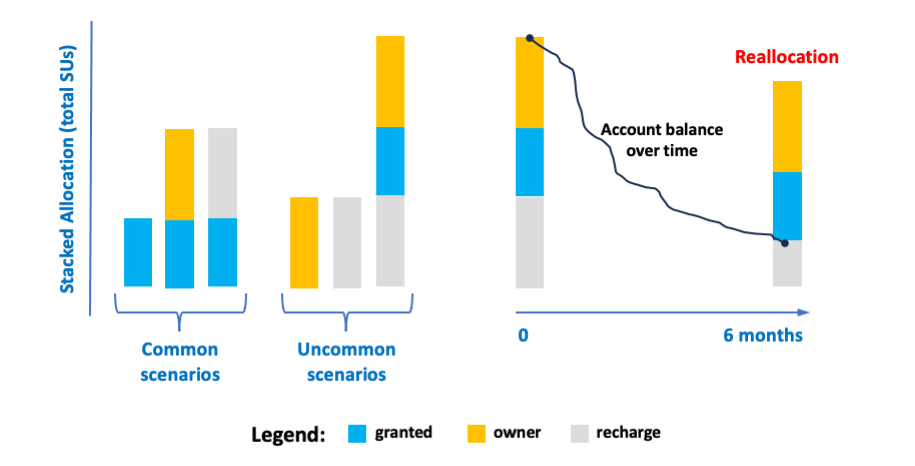2. Reallocation
2.1. Overview
- The vision defined in 2016 was that any
Faculty member at UCI could request up to 200,000 core hours/year at no direct cost.
UCI invests in new equipment every year to reach this particular goal. The RCIC executive committee also approved a plan that would not result in over-allocation of HPC3.
- There are numerous challenges in providing a fair access to these hours:
Any hour that a computing core sits idle is computing that is lost forever.
Actual computing needs are quite uneven. Some research groups need significantly more than 200K hours/year, some significantly less.
Usage by any group is uneven throughout the year. Bursts of computing followed by periods of low use is common.
- To accommodate these challenges, these guiding principles are adopted:
Reallocation is processed automatically and is based upon a lab’s previous 6 month utilization and available hours on UCI-purchased hardware. Reallocation schedule is available via account balance command.
Reallocation is re-computed every 6 months.
Reallocation of granted hours is recomputed as available hours over the next 6 month period.
Reallocation date is based on the lab account’s creation date and takes place in the middle or end of a calendar month. For example, if a lab was created on January 30 th, the next reallocation will happen on July 30 th.
Unused hours in the previous 6 months are considered lost, there is no roll over.
2.2. Stacking and Consumption
No cost allocation
200K hours/year
Purchased core hours
if any were bought
Converted hours from owned hardware
if any were bought
At the beginning of every reallocation period these hours are lumped together to make a total or stacked allocation:

Fig. 2.1 Stacked Allocation and Order of Debiting
There are six different stacking scenarios with the most common being: granted only, granted+owner, and granted+recharge.
- Order of debiting stacked allocation:
- 1. Owner SUs2. Granted SUs3. Recharge SUs
This ordering is important when RCIC recomputes how many granted hours should be given during reallocation.
2.3. Granted hours
The total number of hours UCI can grant to faculty is limited by number of UCI-owned resources and the total request from faculty. To support the largest number of requests possible, RCIC allocates granted hours based upon actual use over the previous 6 months (2 installments per year). The goal is to accommodate the reality that different research programs truly have different levels of computing requirements.
There are 5 bins for no-coast UCI-funded allocations (these are allocations for 6 months). We call this the base allocation:
Hours |
Note |
|---|---|
100K hours |
Max allocation over 6 months |
75K hours |
|
50K hours |
|
25K hours |
|
12.5K hours |
Min allocation over 6 months |
Any faculty member who requests hours is automatically granted 100K hours as their initial base allocation. The next 6 month allocation is based upon actual utilization in the previous 6 months and the reallocation is calculated as follows:
- usage > 85% base:
allocated in the next larger bin up to max allocation.
- 50 % < usage < 85 %:
no change in allocation
- 25 % < usage < 50 %:
allocated in the next lower bin until minimum
- usage < 25%:
allocated two lower bins down.
- usage < 100 hours:
set to Min allocation
Current Allocation |
Usage |
Reallocation |
Reason |
|
|---|---|---|---|---|
75K |
70K |
100K |
Usage greater than 85% |
|
75K |
58K |
75K |
Usage in range 50% - 85% |
|
75K |
37K |
50K |
Usage is < 50% |
|
75K |
15K |
25K |
Usage < 25% |
|
75K |
0 |
12.5K |
No usage. Reduced to minimum |
|
Note
The algorithm above applies only to no-cost granted hours in the stack.
2.4. Converted hours
Core-hours (SUs) converted from owner hardware are not binned. They are computed for what the hardware could deliver over the next 6 month period using the formula:
These are deposited for the useful lifetime of the hardware which is defined as warranty period + 1 year. Most hardware in HPC3 is purchased with 5 year warranties. This means that a node will generate hours using the above formula for 6 years. This assumes that the actual hardware is still functional for 1 year after warranty (that’s usual).
Any SUs not utilized in the previous 6 months are lost. This is no worse than if the hardware had been dedicated to the owner, but went unused for periods of time.
2.5. Purchased hours
Purchased cycle hours are expected to be used within 1 year and should be used on fairly regular basis. As per MOU for cycle purchases, unused cycles are forfeit after 18 months.